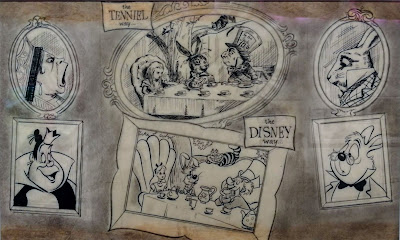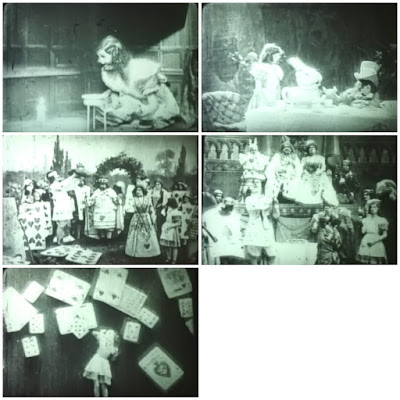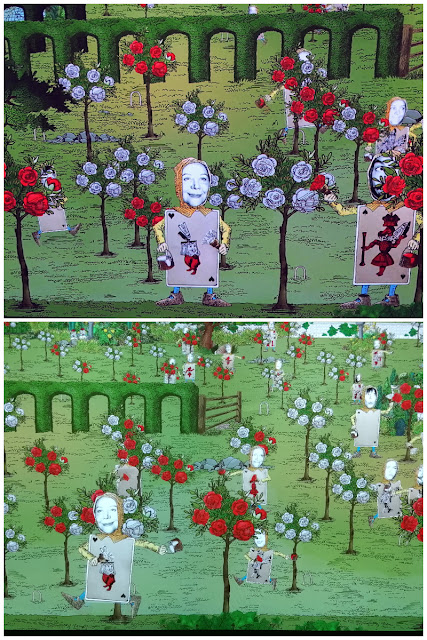The other reason for sharing Wonderland is that there is no sewing to share with only two knit tops sewn in the nearly six weeks I have been staying safe at home. Two more versions of Katherine Tilton's Vogue 8710 view B emerged from the sewing machine. Maybe now there are three versions an actual blog post about sewing could appear in the near future.
The exhibition developed by the Australian Centre for the Moving Image is described by Te Papa as:
an interactive exhibition that celebrates Lewis Carroll’s timeless stories. Explore Alice’s journey from book to screen, through original picture books, magic lanterns, and more than 40 films and 30 television programmes. Then join an immersive Mad Hatter’s Tea Party that comes alive with digital wizardry. You’re bound to get lost on the way. Squeeze into a tiny house, climb a giant chair to peek into Alice’s room, and post your soldier avatar on the Queen’s croquet ground. The closer you look, the more you’ll discover – not everything is what it seems!So into Wonderland - lets fall down the rabbit hole...
For those who don't have time to scroll through this picture heavy post Google kindly made a little video of the event.
In case we got lost we were provided with the Lost Map of Wonderland. These maps were produced for different characters - I should really have asked for the White Rabbit instead of the Queen of Hearts. The Queen does have a scale of impatience, which is appropriate for me, although I would never be quite as extreme to vary between hold your tongue and off with your head.
Through the book lined corridor into the exhibition - some great childhood favourites here.
Pages from the original manuscript
Charles Lutwidge Dodgson better known by his pen name Lewis Carroll told the story to entertain three girls as he and a friend (Reverend Robinson Duckworth) rowed up the river Isis one afternoon in 1865. The story featured a bored little girl named Alice who goes looking for an adventure. One of the girls Alice Liddell asked Dodgson to write it down for her. The exhibition featured facsimiles of the original manuscript (held in the British Library).
 |
| Pages from the original manuscript with Dodgson's drawings |
Dodgson added his own illustrations to the book but for its publication he approached John Tenniel to illustrate it. The illustrations of John Tenniel are my favourite.
Not a great admirer of Disney's depiction of Alice and friends.
The film through the ages
Alice in Wonderland was a fabulous book for early cinematographers where the imagination could run wild. We spent so long watching the films from the early twentieth century through to the 1930's that we had to rush the end of the exhibition before it closed.For those who are as much of an Alice nut as I am I have included links to the films on YouTube where I could find them (sometimes only snippets). It was truly amazing to see such early films and how they adapted the story. Despite some of them being over a 100 years old they didn't seem as dated and consequently amusing as early science fiction films. They are also in remarkably good condition considering their age and how they would have been treated in their early life (not as treasured archival pieces of cinematography).
One of the doors in the Hall of Many Doors led to a cinema where we watched the first version of Alice in Wonderland directed by Percy Stow and Cecil Hepworth in 1903. The British Film Institute restored some of the film and its original tinting. The original film ran for about twelve minutes, the restored version is just over nine minutes long. Now thanks to the British Film Institute and YouTube you can watch it too...
Stills from Alice in Wonderland directed and written by W W Young in 1915 a silent film starring Viola Savoy as Alice. I really appreciated the music that accompanies this film found on YouTube.
Stills from Alice's Adventures in Wonderland, a silent film directed by Edwin Stanton Porter in 1910 with Gladys Hulette as Alice.
Stills from Alice in Wonderland, directed by Norman Z. McLeod in 1933 with Alice played by Charlotte Henry.
Stills from Alice's Adventures in Wonderland, a silent film directed by Edwin Stanton Porter in 1910 with Gladys Hulette as Alice.
Stills from Alice in Wonderland, directed by Norman Z. McLeod in 1933 with Alice played by Charlotte Henry.
Then come the more modern versions like this 1966 television musical of Alice Through the Looking Glass directed by Allan Handley with Judi Rolin as Alice. A fun version but I much preferred the earlier silent films.
The most recent version is from 2010 by director Tim Burton with a star studded cast led by Johnny Depp.
 |
| Early costume designs by Colleen Atwood for Helena Bonham-Carter's Queen of Hearts |
And the official Disney trailer.
Fascination with Alice takes many forms
Magic lantern projectors were developed in the 1600s using a lens and a candle to project an image painted on a glass slide onto a wall. By the 1800s skilled operators could entertain audiences, creating the illusion of movement by wheeling the magic lantern towards and away from the screen. Narration sound effects and music added to the show. Not so skilled operators could harm (or even kill) their audience with projectors illuminated by limelight!
 |
| Johnson Optiscope Magic Lantern projector, Houghton-Butcher, UK circa 1910 |
An assortment of magic lantern slides, some by W Butcher and Sons Ltd, London 1905-08
The Toy Jektor film viewer saw this Dandy Film released in 1933. Movie jektors or toy film strips were created by printing images and text in three colours on 35" strips of translucent paper that were rolled onto wooden dowels and stored in boxes. They were viewed through a toy film projector to create simple animations.
Character sketches from the 1933 Alice in Wonderland film by Norman Z McLeod
This scene design from the stop motion and live action 1988 Czechoslovakian film Alice by Jan Švankmaier was much darker than the other items in the exhibition and of course a snippet of this film can be found on YouTube. Its original Czech title is Něco z Alenky, which means "Something from Alice" being a loose adaptation of the book.
The Mad Hatters virtual tea party
You enter a completely white room and take your place at the table, images play over the walls, table and crockery creating different illusions. In a couple of pictures I managed to capture the transition between scenes.Playing croquet
On the back of the exhibition map was a playing card where we could stick on our own design in the interactive studio at the end of the exhibition. I really wanted to be the White Rabbit in his Court attire but could only find his legs so added the kings head and drink me bottle to make my own unique character. Once the playing card was completed to your satisfaction it was placed in a slot with your head in a cut out hole and you become the soldier avatar on the Queen's croquet lawn painting the white rose bushes red. Being a loyal Yorkshire women it was a challenge painting the white rose of Yorkshire red for the House of Lancashire (War of the Roses all over again!) |
| My playing card |
Acknowledgements
Fabulous exhibition that brings joy even through these photographic memories. I echo my thanks to those of Te Papa to everyone who brought this exhibition to life.Along the waterfront to Te Papa
On the walk to Te Papa along the waterfront we came across these knit bombed flag poles. The characters where fabulous and the photographs don't do them justice. They added another layer of colour to a wonderful day.Outfit of the day
I don't normally remember to take photographs of me made outfits but as I went to Wonderland with a fellow dressmaker photographs were taken with my very favourite White Rabbit, as the adventure continued. |
| The Cut Make Trim dress, Green Pink Kantha jacket and United Nude Mint Fold booties |
And finally an ode for our times...
























No comments:
Post a Comment